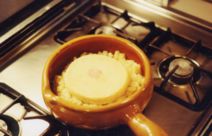Tartiflette: Difference between revisions
imported>Hayford Peirce (fixed rights on second image -- woof! enough of this for today!) |
imported>Hayford Peirce (added some line breaks to get the recipe's first line to line up) |
||
| Line 11: | Line 11: | ||
The word ''tartiflette'' is perhaps derived from the Piedmontese word for potato ''tartiflâ'', although a number of other European languages have words for potato that are similar. | The word ''tartiflette'' is perhaps derived from the Piedmontese word for potato ''tartiflâ'', although a number of other European languages have words for potato that are similar. | ||
'''A recipe for tartiflette''' | '''A recipe for tartiflette:''' | ||
The following recipe is a combination of ingredients and techniques from several different sources. It is, however, well within the classic definition of a tartiflette. | The following recipe is a combination of ingredients and techniques from several different sources. It is, however, well within the classic definition of a tartiflette.<br /><br /> | ||
1-3/4 pounds Yukon Gold potatoes (5 or 6 medium-sized ones, all the same size) or waxy boiling potatoes<br /> | 1-3/4 pounds Yukon Gold potatoes (5 or 6 medium-sized ones, all the same size) or waxy boiling potatoes<br /> | ||
Revision as of 23:24, 28 February 2008
Tartiflette is a hearty cheese and potato dish from the mountainous Savoie region of eastern France, where it originated in the Aravis valley, the home of Reblochon cheese. It is not, however, a traditional dish and was, in fact, created and launched only in the 1980s by the Reblochon trade association in an attempt to increase sales of their cheese, which is made from ewe's milk. Different valleys in the area have different methods of making tartiflette and every household probably now has its own recipe. All of them, however, contain, at a minimum, potatoes, Reblochon cheese, and some kind of cured meat such as slab bacon or salt pork. Additional ingredients can be various permutations of butter, onions, local wine, and/or cream. Baked for about an hour before serving, tartiflettes generally have an attractive crispy, golden brown crust.
They have become popular at many alpine restaurants during the ski season because they are flavorful, nutritious, relatively easy to prepare in large quantities, and can be kept warm without noticeable deterioration in quality.
The word tartiflette is perhaps derived from the Piedmontese word for potato tartiflâ, although a number of other European languages have words for potato that are similar.
A recipe for tartiflette:
The following recipe is a combination of ingredients and techniques from several different sources. It is, however, well within the classic definition of a tartiflette.
1-3/4 pounds Yukon Gold potatoes (5 or 6 medium-sized ones, all the same size) or waxy boiling potatoes
5 or 6 ounces slab bacon, or salt pork, cut into lardons about 1" x 1/4" by 1/4"
2 tablespoons butter
1 medium onion (about 6 ounces, peeled), finely chopped
1/4 cup dry white wine or dry vermouth
6 tablespoons heavy cream (1/4 cup plus 2 tablespoons)
salt and pepper to taste, probably at least 1/2 teaspoon salt, possibly more
1/2 of a 1-pound Reblochon cheese
- Use potatoes that all the same size so that they will cook evenly. Boil them in their skins for exactly 20 minutes, until they’re just beginning to get tender. Do not overcook! Rinse with cold water to stop the cooking.
- While still warm, peel the potatoes with your fingers, then use a large, very sharp knife to cut them into slices about 1/3-inch thick. Then cut the slices into rough cubes.
- While the potatoes are cooking, slice the slab bacon or salt pork into slices about 1/4-inch thick. Then cut into lardons about 1/4-inch across.
- Melt the butter in a large sauté pan, then cook the lardons over medium-high heat until crisp and golden brown. Remove with a slotted spoon and set aside, leaving the bacon fat in the pan.
- Preheat the oven to 350 degrees.
- Cook the onions in the bacon fat over medium heat, stirring often, until wilted and slightly golden. Drain in a strainer, pressing with a spoon to remove as much fat as possible, and leave them there.
- Pour off the fat in the pan, return the bacon and onions, and add the wine. Cook over high heat until the wine is nearly evaporated.
- Add the diced potatoes and cook for a minute or so, stirring constantly until all the ingredients are well mixed together.
- Add the cream and salt and pepper to taste. Try using a little more salt than you might think is necessary, at least 1/2 teaspoon. Stir all the ingredients together for a minute.
- Lightly butter the inside of an 10- or 11-inch earthenware baking dish. Add the potato mixture and smooth the surface.
- Cut the Reblochon in two down across the top so that you have two pieces in the shape of a half-moon. Put one of the pieces away for another use. Use a sharp knife to lightly score the crust of the remaining half-cheese about every inch, including its side. Then carefully slice horizontally through its center so that you now have two half-moon pieces.
- Place the two pieces of cheese crust-side-up on top of the potatoes so that they form a circular cheese again. Cover the dish tightly with aluminum foil and bake in the center of the oven for 1 hour.
- Remove the foil and stir the cheese, including the crust, into the potatoes, mixing well.
- Place 5 or 6 inches under the broiler and cook until golden brown on top.

